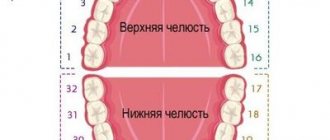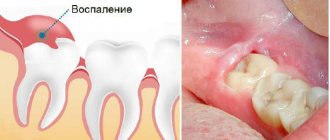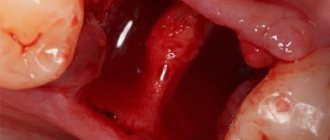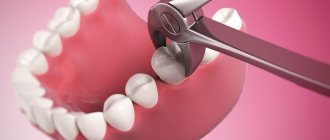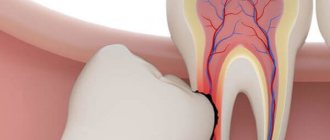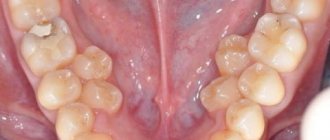Eighth tooth, figure eight, third molar: how many wisdom teeth does a person have?
In the modern world, wisdom teeth are considered something of a rudiment, that is, an organ that has lost its significance in the process of evolutionary development. That is why their appearance is greatly delayed or may not take place at all. As a rule, an adult has a maximum of 32 teeth, including 4 wisdom teeth.
However, a person can have more than 4 wisdom teeth - such cases occur quite often in dental practice! Two or more wisdom teeth may erupt, or none may appear: it all depends on the individual characteristics of the body and the structure of the dentofacial apparatus. Although a set of 32 molars is considered ideal, a number of 28 to 32 is also considered normal.
Differences between upper and lower wisdom teeth
Compared to the upper ones, the lower “eights”, as a rule, have a larger number of root canals. In addition, their removal is more difficult because the bone tissue in the lower jaw is considered denser. Otherwise, there are no significant differences.
Delete or leave unchanged
This is a topic of active debate among dentists and researchers. Regardless of how old people are when wisdom teeth appear, doctors recommend removing them. There are a number of contraindications for removal:
- missing 1 or 2 molars (6 and 7 in a row);
- the tooth position is vertical;
- history of viral infections in the active stage;
- There is a possibility of treatment for caries.
Age 17, 20 or 35 – it is not so important at what age a wisdom tooth comes out in the jaw. If you feel good, there are no acute inflammatory processes in the gums, and there is no crowding of other teeth, removal can be postponed. This is normal dental practice. If there is aching pain, intoxication with high fever, signs of gumboil, removal is indicated in 99% of cases. Knowing the information at what age wisdom teeth come out in men and women, you can mentally prepare for this process. Everything else and the peculiarities of the development of events depend on genetics and nature. Monitor your condition, undergo preventive examinations on time and, if urgently necessary, seek dental care.
Why is wisdom tooth called this?
Wisdom teeth usually begin to erupt after adulthood. Compared to other molars, which appear in childhood, we acquire wisdom teeth already as mature people, so they got their name precisely based on age. Another popular designation for wisdom teeth is third molars or “figure eights.” Here, too, everything is obvious: if you draw the midline of the face, you can see that the wisdom tooth is the eighth tooth on the left or right side.
What you should not do if your wisdom tooth is sick:
- Under no circumstances should you apply any heat to your cheek (including heating pads), or rinse your mouth with warm water. As a result of any warming, the infection can spread even more, even suppuration of the bone tissue is possible.
- It is not recommended to put painkillers on the tooth area, because as a result, not only will the pain not be relieved, but an ulcer may form on the gum.
- Under no circumstances should you use advice given by friends and relatives. This or that remedy can help them, but the exact cause and diagnosis are unknown, as a result of which your wisdom tooth is swollen.
Time of appearance of wisdom teeth
The wisdom tooth “climbs in” much later than the other teeth. “Eights” do not have rudiments in the form of milk teeth: they appear at 3–5 years, and the crown part begins to form at about 12 years, when the replacement of temporary teeth with permanent ones ends. Children's wisdom teeth usually do not emerge until they are 16 years old. The average age of their appearance is 21–25 years, but there are cases of late eruption after 30 years. Sometimes eights may not grow at all.
Many people are also interested in how long the wisdom tooth is cut (how long the wisdom tooth grows until the crown part appears above the gum). On average, this process takes from several days to a month, but the roots of the “eight” are formed several years after its eruption.
Are there any specifics to removing wisdom teeth?
Of course, there are some peculiarities when removing wisdom teeth. The doctor’s task is to make the removal process as accurate as possible, as atraumatic as possible - in principle, like the rest of the teeth. But in the case of a wisdom tooth, there are some peculiarities of anatomy.
The peculiarities are that the figure-eight tooth is located quite far away and quite well hidden. But at the same time, using modern equipment, modern materials and having experience, you can remove wisdom teeth quickly and accurately enough without consequences or injuries.
Symptoms of wisdom teeth erupting
Many people ask what to do if a wisdom tooth grows? The answer is obvious: contact a dentist who will monitor the entire process and be able to take the necessary measures in a timely manner if complications arise. The signs of a wisdom tooth (its eruption) are different for everyone, and some of us do not notice their appearance at all. But not everyone is so lucky: if a wisdom tooth begins to grow, then in many cases this is still accompanied by some discomfort.
How to understand that a wisdom tooth is growing?
- Inflammation and swelling of the gums appear in the eruption area.
- There is pain in the jaw area.
- The temperature rises.
- A characteristic hood forms over the coronal part of the wisdom tooth. If the tooth remains impacted (not fully erupted), the hood often becomes the cause of pericoronitis.
Complications associated with teething
With pathological germination of the figure eight, a number of complications can develop. A common disorder is pericoronitis. The disease is associated with inflammation of the tissues of the jaw and mucous membranes of the mouth.
Characteristic signs of pericoronitis:
- the appearance of severe swelling and redness in the eruption area;
- sore throat when swallowing;
- deterioration of health;
- weakness;
- temperature increase;
- discharge of purulent masses when pressing on the gums.
Often pericoronitis becomes chronic, which is accompanied by pain and discomfort when pressing on the problem area. An abscess may form in place of the tooth.
Carious lesion is another consequence of improper eruption of figure eights. The fact is that the last molars may fit too tightly to the sevens, which makes it difficult to naturally clean the dental space from plaque and bacteria. As a result, caries develops with all its characteristic symptoms:
- darkening of the enamel;
- pain when chewing;
- tooth sensitivity.
Sometimes it happens that the figure eight comes out on the surface of the already affected gum.
Periodontitis appears after the eruption of the last molar. The pathology is characterized by inflammation of the gums due to the inconvenient location of the wisdom tooth in the gum. In this case, plaque and bacteria from the oral cavity are almost impossible to remove using standard hygiene measures. Bacteria in the space between the gum and tooth provoke inflammation and swelling of the soft tissues of the mouth. If a visit to the dentist is untimely, periodontitis is complicated by gumboil or periostitis.
What to do if a wisdom tooth comes out and your gums hurt
Symptoms of flux manifest clearly and are accompanied by:
- temperature rise to 40 degrees;
- swollen cheeks;
- swelling spreading to most of the face;
- intoxication of the body;
- excruciating pain.
As a result of abnormal eruption of the figure eight, a cyst can grow - a benign tumor filled with clear liquid. It contains particles of dead cells, bacteria and food debris. You can notice a cyst by protruding gums and discomfort when chewing food. Rarely, a cyst is accompanied by severe pain.
The appearance of a wisdom tooth above or below can cause damage to the trigeminal nerve. If it is violated, there is involuntary twitching of the face and severe sharp pain. In severe cases, facial paralysis may occur.
Abscess is one of the most severe complications associated with the pathological eruption of the last elements. It develops in the most patient patients. Among the signs of the disease are:
- sharp putrid odor from the mouth;
- constant feeling of bitterness;
- heat;
- throbbing pain.
When the abscess goes inside, phlegmon or an extensive inflammatory process develops. Swelling spreads to the entire face.
Cellulitis is a complication that can cause the patient’s death
You need to be attentive to all the symptoms that manifest the eruption of wisdom teeth. If pain persists for more than 2-3 days, then you need to seek help from a dentist. It is recommended to independently relieve the symptoms of the condition only if it is not possible to visit a specialist. For this purpose, it is permissible to use painkillers and traditional medicine. During a visit to the doctor, it is necessary to tell you that pain relief measures were taken regarding the problem unit.
Wisdom tooth root
Despite the fact that visually wisdom teeth are practically no different from ordinary molars, there are still some differences. We are talking, first of all, about root canals: in figure eights they are much more curved, so it is very difficult to carry out endodontic treatment, taking into account also where the wisdom tooth is located (in the most inaccessible area of the dentition). The number of roots of wisdom teeth also varies: there may be four or five, or maybe even one (when several canals grow together).
How long do eights grow?
The period for the last element to appear on the surface ranges from 4 weeks to 10 years. On average, patients may experience discomfort from the eruption of wisdom teeth for up to 1.5 months. After the crown appears, the discomfort subsides. Then there is a pre-formation stage, which can take up to 5–7 years. An element is considered formed after its roots appear, which can number from 3 to 5.
Only a doctor can decide whether to remove the problematic element or not. The main indications for surgical intervention are chronic pericoronitis, compression of the roots of an adjacent tooth by the figure eight, damage to the soft tissue of the gums on the crown of a molar. If there are no problems when cutting through the unit, then experts leave the eights untouched. These teeth are as important as all other elements, despite the fact that they do not take part in the digestion of food.
Squeezing an adjacent element with a figure eight
The last molars prevent the remaining teeth from moving to the side and prevent various malocclusions. When prosthetizing sevens, the last molars can be considered as a support for orthodontic structures. For this reason, doctors try to preserve the element even if it is damaged by caries.
Wisdom tooth growth: what should you be wary of?
A correctly positioned wisdom tooth (correct wisdom teeth) rarely causes discomfort to its owner, but a complex wisdom tooth can lead to very unpleasant complications. This is usually the name given to the third molar, which has an incorrect position of the rudiments or provokes complications when erupting. You need to understand that, being a rudiment, the figure eight literally wedges itself into the dentition: in some cases this happens quite organically, but in others it does not. In most situations, the culprit is incorrectly formed rudiments of wisdom teeth, located too deep, horizontally, or almost resting on neighboring teeth.
Complications after wisdom tooth removal
What may be the cause of complications after removal of figure eights?
Complications after removing the figure eight - yes, they exist. Complications are different: they occur directly during the removal procedure, there are delayed ones, blood vessels may be damaged, and bleeding may occur. There may be a fracture of the jaw, a breakage of a section of bone tissue that is located in close proximity to the wisdom tooth.
Long-term complications – for example, wound infection in the case of unsterile instruments. If the doctor did not warn the patient that he needs to take antibiotics prophylactically for an impacted wisdom tooth.
What are the complications after wisdom tooth removal?
After the removal of a wisdom tooth, there are complications of different etiologies: they can either arise immediately or be delayed. Bleeding may immediately occur, your jaw may break, a piece of bone may break off (both small and large) - then your jaw will begin to hurt. You can tear the mucous membrane, injure a neighboring tooth, break a neighboring tooth, etc. Your gums or throat may begin to hurt.
Delayed complications are oral infection, periostitis, alveolitis, inflammation of bone tissue.
Can the temperature rise after wisdom tooth removal?
After the removal of a wisdom tooth, the temperature may rise in people who are very nervous or have suffered a lot of stress. This will be a vegetative-vascular reaction, and once the temperature can rise to 38.5-39 degrees. Once. It can be brought down by the use of antipyretic drugs and, accordingly, it should no longer be present. There may be a low-grade fever of 37 degrees, 37.1-37.2, for several days after removal. This does not have any consequences, this is normal, but you should, of course, inform the doctor about this so that he takes this fact into account and adjusts his prescriptions.
Can gumboil appear after wisdom tooth removal?
After wisdom tooth removal, gumboil may appear. This can happen as a result of a wound becoming infected. For example, the use of non-sterile instruments, non-sterile materials. This can also be a result of the removal of an impacted wisdom tooth, for example, if the doctor “sutured it in tightly”, and there are a lot of bacteria in our oral cavity, and did not prescribe antibiotic prophylaxis. In this case, flux is likely to occur.
Complications resulting from the growth of “wise teeth”
- Malocclusion and crowded dentition.
In this case, the eighth tooth simply does not have room for normal eruption and placement. - Pressure and damage to the adjacent tooth.
If there is not enough room for the eight to grow, it begins to push against its neighbors. - Pericoronitis.
When the eruption of the figure eight is difficult, the soft tissues in this area become inflamed due to the activity of pathogenic bacteria. A so-called gum hood forms over the tooth, in which food debris accumulates, which provokes infection. The main syndrome is severe aching pain, inflammation, and sometimes purulent discharge. - Inflammation of the trigeminal nerve.
Incorrect position of the wisdom tooth can affect the trigeminal nerve, which manifests itself in the form of pain and uncontrollable twitching of the facial muscles. - Osteomyelitis and dental cyst.
Cost of wisdom teeth removal in Moscow
The price of removing one wisdom tooth in Moscow clinics, if we talk about low-traumatic removal of both lower and upper wisdom teeth, can start from a price of 15 thousand rubles
and higher. The fact is that when removing a figure eight, the cost of bone material, which is used for small bone grafting, can be added to the price of the removal itself, since after removing a deep-lying figure eight, a void may form, which, you see, needs to be eliminated due to fears of the development of atrophy bones in this area.
But many doctors, both in Moscow and in the regions, neglect bone grafting and simply suturing the wound, thereby reducing the cost of wisdom tooth removal to 8-10 thousand. The choice of price always remains with the patient, but the patient also needs to evaluate the risks of such removal, look a little into the future and understand that saving 5-10 thousand rubles at this step may result in future problems with the 6th and 7th chewing teeth ... But this is a completely different story.
Why do people need wisdom teeth?
Are wisdom teeth necessary? This is perhaps one of the most common questions asked by millions of patients who come to the dentist’s office. Ancient people who lived tens of thousands of years ago had a larger and more massive jaw, so they could accommodate more teeth. This helped chew hard and tough foods. Over time, the need for this disappeared, so wisdom teeth gradually became a vestigial organ. Of course, only nature knows the exact answer to the question of why wisdom teeth grow in modern people, but one should not think that they are absolutely useless. Despite the fact that third molars are almost not involved in distributing the chewing load, wisdom teeth in adults can become a support for a prosthesis, and also prevent bone loss in the absence of neighboring molars.
How to relieve pain if a wisdom tooth grows and your gums hurt.
The growth of wisdom teeth is not painless for every person, so most people need to know what to do in case of inflammation of the gums around the wisdom tooth and acute aching pain.
If there is inflammation, pain, or if the cheek is swollen near the wisdom tooth, you should contact your dentist, he will conduct an examination and take the necessary measures to eliminate symptomatic manifestations.
If the pain begins in the evening or it is not possible to quickly contact a specialized specialist, doctors recommend several ways to reduce pain:
- Rinse the growth with calendula tincture after eating - this will reduce the intensity of the inflammatory process and also reduce pain;
- Rinse your mouth with a solution of baking soda in water, at the rate of 1 teaspoon of soda per 1 glass of water (200 grams) - soda calms inflammation and also reduces pain;
- To rinse the mouth, you can use decoctions of chamomile, oak bark, chicory root, as well as sage tincture and propolis;
- Anti-inflammatory, painkillers and antibacterial drugs - use according to the instructions. They help reduce pain, reduce swelling, and also eliminate the negative bacterial influence at the site of tooth eruption.
In case of acute unbearable pain, as well as the absence of the above remedies, you can use cold water to reduce pain: take a glass of cool water, put a small amount in your mouth and hold it in the area where the wisdom tooth is erupting - this can quickly reduce the level of pain. However, this method has one negative feature - the pain intensifies almost immediately after stopping holding cool water at the site of gum inflammation, for example, near the hood of a wisdom tooth.
general information
Wisdom teeth are third molars (8 in the dentition, “eights”) that erupt at 18-25 years of age. Their appearance is strictly individual, for some people they may not appear throughout their lives, for some they will appear at the age of 12, and others will face this problem at the age of 40.
Previously, when people mainly lived by hunting and ate tough, poorly processed food, they needed developed jaws and a large number of teeth for high-quality chewing and assimilation of food. Modern man's diet has changed somewhat, food has become softer, well-processed, and no longer requires intensive chewing.
In the process of evolution, the jaw has decreased by 20-50 mm, but this is already enough for the very last tooth to become cramped. As a result of the reduction in “living space” 8, teeth rarely grow in the correct plane, without injuring neighbors, become aligned with the dentition and participate in chewing. Most often, they grow in a horizontal plane with deviation from the dental arch, cut into adjacent soft tissues and cause an inflammatory process in them.
How many wisdom teeth should a person have?
Now 28 teeth are enough for us, but the stubborn organism continues to lay down 32 rudiments, just as it laid down for ancient man. These 4 extra teeth are wisdom teeth, so named because they erupt late compared to all other teeth. In total, an adult has only 32 teeth, of which 28 are permanent and another 4 “eights,” which can erupt at any time and in any quantity.
How long does it take to cut a wisdom tooth?
Eights are problematic lesions; they rarely occupy the correct position and even less often erupt quickly. It all depends on the individual structure of the lower jaw. If its arch is short, then there will not be enough space for wisdom teeth.
How long teething will take cannot be predicted. Sometimes this lasts for several months or many years. The longer, the higher the likelihood that the roots of the figure eight will twist or bend.
It is believed that the number eight is a rudiment that modern man does not need. In ancient times, when people ate a lot of roughage, the load on the jaws was higher. Therefore, the dentition was longer, and there was enough space for the eight. But modern man eats processed food, so the length of the jaw has gradually become shorter. This made the face shape more attractive, but there was less space for teeth. It is not surprising that for some people they do not erupt. If eights grow normally, they need standard care and observation by a dentist.
Growth period of eights
The average growth period for wisdom teeth is 18-25 years. But they may not erupt at all, and even their rudiments will not be formed inside the bone tissue. In some situations, they can form completely, but remain inside the bone. According to research, approximately 70-80% of the world's population still grows the outermost teeth.
Growing pains
Only some lucky people have wisdom teeth that grow completely, straight, and do not cause any trouble during eruption. Among the main problems that accompany their growth are the following:
- Impacted or semi-impacted teeth, which have formed completely inside the bone tissue, but have not erupted (or partially appeared). They can be vertical, horizontal, or even with their roots up. When positioned laterally, such teeth very often exert increased pressure on neighboring ones, which leads to acute pain,
- A gingival hood forms above the tooth: this is a small area of the mucous membrane that forms during the slow eruption of the tooth. The difficulty is that bacteria and food debris often accumulate underneath it, which are difficult to remove due to the fact that the tooth is very far away - it’s practically impossible to get to it. This causes acute inflammation, which often develops into purulent,
- dystopia or positional imbalance: eights do not have milk precursors, in addition, they grow at a time when the jaw bone has ceased to develop and form. Therefore, they often grow crookedly and do not stand in place. At the same time, they can overlap other crowns, overlap with neighbors, cause injury to the mucous membrane, which will complicate hygiene and provoke inflammatory processes,
- growth immediately with caries: they are very difficult to clean because they are located far away. Patients experience particular difficulties when the mucous membrane is inflamed, since cleaning in such situations is accompanied by acute pain.
In general, growth disturbance leads to a change in the normal functioning of the entire dental system. Soreness occurs, the patient often complains of pain when opening the mouth and moving the lower jaw. Due to pressure on neighboring teeth, they become displaced and cause malocclusion. A fairly common consequence is crowding of the incisors, which occurs precisely as a consequence of impaired growth of the figure eights.

